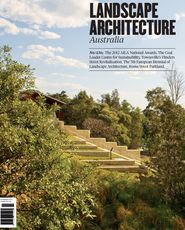This year’s AILA national awards have acknowledged twenty-four projects across Australia and two visionaries within the field of landscape architecture. The jury of five was assigned a tough task given there were more than eighty submissions – a substantial increase on last year. The awards program is structured on a set of basic criteria across the categories of Design, Planning, Land Management, Research and Communication, Urban Design, and Leadership.
The awards not only seek to acknowledge exemplary practitioners and projects in landscape architecture but apply a magnifying glass to the current status quo in the field. Importantly, the awards play a role in raising awareness of the profession among the wider public, highlighting the scope and role of the discipline within the public realm, spotlighting current best practice projects, and promoting visionary ideas and practitioners around the country. Promotion is critical to a profession that often flies under the radar of those external to the field. For practitioners the awards offer a moment of stillness on the pond and the chance to catch a glimpse of their own reflection. So how is it all looking in 2012?
Top of the list this year are projects that cast landscape architects as “agents for change.” As a profession we are not only demonstrably concerned with fulfilling the basic and essential prerequisites of a project brief (appropriateness to function, budget etc.) but are demonstrating global leadership in designing solutions that add value at all scales and to all facets of the bottom line. Increasingly, it is important that the profession demonstrates at least an informed awareness of place and role within the global community and defines contributory and participatory activities in relation to a global set of environmental and social challenges.
Agenda 21, which came out of the United Nations Conference on Environment and Development held in 1992, set targets for sustainable human development. In response Australia developed a National Strategy for Ecologically Sustainable Development which, to put it simply, is a mandated global imperative to design human settlements as if the landscape and larger environmental connections matter. It recognizes landscape as a top priority, with potential outcomes relevant at all scales of development and facets of the bottom line. Through this lens, it should be asked: Does the AILA National Awards program address this mandate and other perceived values in rewarding not only innovative design, but technical and policy research and strategies? How do the winning designs/strategies acknowledge interconnections at local, regional, national and global scales? In other words, does the profession project itself and its concerns as “shags on a rock” or do we have a firm foothold and well-informed understanding of the larger connections, indeed of the planet itself? And are we feeding our own inventiveness with world best practice?
Several of the top awards went to practitioners and projects that dealt sensitively with human rights issues, empowered communities and addressed social inequities currently existing in Australia – timely and powerfully compelling, considering that the world is moving towards defining the cultural, social and environmental values that will provide a framework for the future. An example is the United Nations Sustainable Development Solutions Network, launched in September 2012, which will work with governments, universities, United Nations agencies, the private sector and civil society organizations to “identify, demonstrate, and implement the most promising paths to sustainable development.”1
The 2012 Australian Medal for Landscape Architecture went to UDLA’s Yawuru Cultural Management Plan. UDLA’s approach and methodologies assumed no preconceptions about who knew best but considered the land and its traditional inhabitants in devising a “bottom-up” rather than “top-down” approach. Such projects illustrate the potentials and capacities of the profession to knit together complex and competing agendas into guiding principles, designs and masterplans that aim to operate sustainably and at multiple levels. In placing a high value on social as well as environmental outcomes, landscape architects have shown the possibilities and poetry in creating places that are truly unique.
There remains some parsley around the pig in all of this. Exquisitely rendered detail, skilled use of planting, fine attention to materiality and competent execution can be counterintuitive and offer thin overlays to a lack of conceptual substance, low landmark quality and relatively low levels of landscape and social performance. It may be timely to broaden and globalize categories – to recognize emerging practice, international design and sustainable innovative design. Landscape architects and urban designers have a difficult role in negotiating design outcomes within the broad field of stakeholders and competing agendas. Within this context it may also be timely to recognize champions of design in landscape architecture, and to award those who sponsor good design – those individuals and organizations that see great landscape architecture as vital investment in the future of Australian communities. The City of Sydney has, for example, invested in big, city-shaping projects.
But above all, congratulations everyone. This is a brilliant and stimulating forum.
1 Sustainable Development Solutions Network website, unsdsn.org (accessed 13 September 2012).
Source

Discussion
Published online: 1 Nov 2012
Words:
Donna Broun
Issue
Landscape Architecture Australia, November 2012














